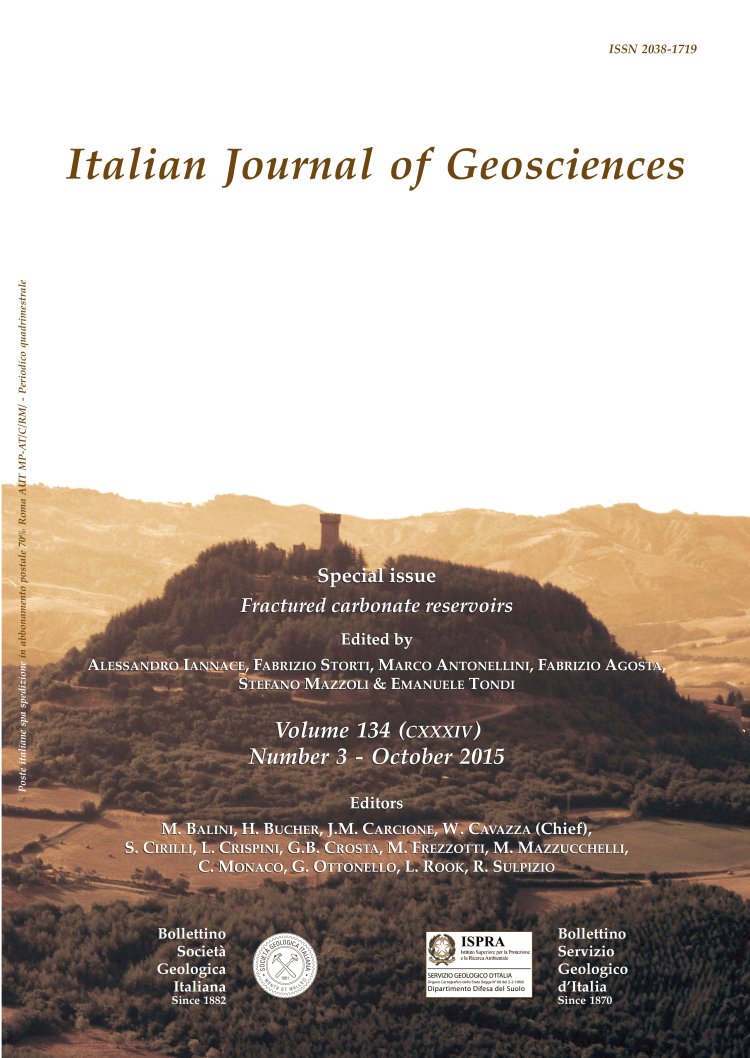
Fracture patterns and fault development in the pelagic limestones of the Monte Conero Anticline (Italy)
Elizabeth N. Díaz General (*), (**), Pauline N. Mollema (**) & Marco Antonellini (**)
(*) Catholic University of Temuco, School of Environmental Sciences, Rudecindo Ortega 02950, 4810721, Temuco, Chile. Phone: +56 (045) 2205344. Corresponding author e-mail: ediaz@uct.cl, lizbeth.0001@gmail.com
(**) University of Bologna, Integrated Geosciences Research Group (I.G.R.G), Via Sant'Alberto, 163 - 48123 Ravenna, Italy, Phone: +39 0544 937318, Fax: +39 0544 937319.
Volume: 134 (2015) f.3
Pages: 495-512
Abstract
Fracture patterns reflect the tectonic history of an area. By studying the characteristics of fracture patterns in outcrops it is feasible to reconstruct the sequence of events which helps to predict the fracture patterns in similar geological settings including fractured reservoirs and aquifers. This paper studies the fracture assemblages exposed in outcrops of the Monte Conero anticline, formed by two principal carbonate formations: the Maiolica and the Scaglia Rossa.
Fieldwork measurements of fracture properties such as, orientation, length, aperture, microscope analysis of thin sections and crosscutting relationships, led to the recognition of a sequence of events and a fault development model that can explain the occurrence and morphology of breccia zones. The fractures occurring in the outcrops of Monte Conero, consist of veins, stylolites, joints, faults with breccias that occur both in elongated zones and in pockets. Veins and stylolites are the most occurring fractures and the highest fracture density occurs in outcrops along the coastline. Veins and stylolites are arranged in various geometries (e.g. en-echelon) which influence the connectivity with other fractures. Veins and stylolites play a fundamental role in the fault development process. Maiolica and Scaglia Rossa Fm. show different processes of fault development. The initial phase of fault development consists in both formations by shearing along pre-existing veins and the connection of veins by tail-joints.
These tail joints break up the rock in between overlapping segments of sheared veins. In the Maiolica Fm, both joints and stylolites form at the tip of faults. The discontinuities at the tip of the faults are explained by high local stress concentrations. The relationships between fracture types observed at the micro-scale are similar to the ones observed at the outcrop-scale. Three different geological episodes were identified and each one is associated to a rotation of the directions of the principal stresses, the first episode formed a set of veins at high angle to bedding, the second episode formed sets of stylolites and the third episode caused slip along the pre-existing veins with formation of new sets of veins, stylolites, and breccia. The fault development process in Monte Conero is related to large and local scale tectonic events during which the veins, stylolites, joints and faults were formed and connected at different stages of the folding process, generating breccia zones. Breccia zones in faults are the only structures that contribute substantially to the secondary porosity of the low-porosity Conero's carbonate rocks.
Fieldwork measurements of fracture properties such as, orientation, length, aperture, microscope analysis of thin sections and crosscutting relationships, led to the recognition of a sequence of events and a fault development model that can explain the occurrence and morphology of breccia zones. The fractures occurring in the outcrops of Monte Conero, consist of veins, stylolites, joints, faults with breccias that occur both in elongated zones and in pockets. Veins and stylolites are the most occurring fractures and the highest fracture density occurs in outcrops along the coastline. Veins and stylolites are arranged in various geometries (e.g. en-echelon) which influence the connectivity with other fractures. Veins and stylolites play a fundamental role in the fault development process. Maiolica and Scaglia Rossa Fm. show different processes of fault development. The initial phase of fault development consists in both formations by shearing along pre-existing veins and the connection of veins by tail-joints.
These tail joints break up the rock in between overlapping segments of sheared veins. In the Maiolica Fm, both joints and stylolites form at the tip of faults. The discontinuities at the tip of the faults are explained by high local stress concentrations. The relationships between fracture types observed at the micro-scale are similar to the ones observed at the outcrop-scale. Three different geological episodes were identified and each one is associated to a rotation of the directions of the principal stresses, the first episode formed a set of veins at high angle to bedding, the second episode formed sets of stylolites and the third episode caused slip along the pre-existing veins with formation of new sets of veins, stylolites, and breccia. The fault development process in Monte Conero is related to large and local scale tectonic events during which the veins, stylolites, joints and faults were formed and connected at different stages of the folding process, generating breccia zones. Breccia zones in faults are the only structures that contribute substantially to the secondary porosity of the low-porosity Conero's carbonate rocks.
Keywords
carbonates, fractures, veins, stylolites, breccia, fault development, Monte Conero, anticline, microstructures, porosity, Italy.
Get Full Text